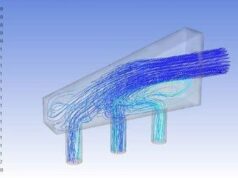MP4 | h264, 1280×720 | Lang: English | Audio: aac, 48000 Hz | 9h 5m | 6.09 GB
Turbulance, Heat Transfer, Transient, Moving Zones & Non Conformal Interfaces, Best Practice Guideline
What you’ll learn
They will learn how to analyze and simulate the engineering models, advanced level
Requirements
Basic Engineering Knowledge with powerful computer
Description
This is an advanced level courses and focus specific main topic,listed below. Also This course is a perfect fusion of CFD theory and software exposure. This course explicitly focuses on solver and post-processing part od typical CFD process using simulation tools Ansys Fluent. Each chapter has specific workshop model,showing how to use the tools(step by step), for doing more practice.
Following topic will be covered in this course;
Chapter 1= To learn how to set up and solve turbulent flows using different turbulence models and near wall treatments, learn how to use the post process y+ and also Turbulence Flow Characteristic, Learn Turbulence Model such as Spalart Allmaras Model, K-E Models such as Standart K-E , Realizable K-E models, K-W models, Calculating Y+, Boundary Layer Profiles,Wall Modelling Strategies such as Using Wall Functions, Resolving the Viscous Sublayers,Enhanced Wall Treatments , Inlet Boundary Conditions. Doing more practice with Workshop model section.
Chapter 2 = Heat Transfer type such as Convection, Conduction, Radiation, Modeling Heat Transfer in Walls such as Mesh the wall, Specified Wall Thickness and Specified Shell Conduction, Conjugate Heat Transfer, Post Processing Heat Transfer and Natural convection of the heated air and modelling thermal radiation. Doing more practice with Workshop model section.
Chapter 3=Focus specifically for Transient(Unsteady CFD Analysis), learn how to Select the suitable Transient Time Step Size, Converge Behavior, Solution Method, Using the Non-Iterative Time Advancement(NITA), Animations-Unsteady Flow Modeling, Post-Processing, Transient Charts, Fourier Transform, Auto saving results during the simulation and generating animations of the solutions. Doing more practice with Workshop model section.
Chapter 4=Inserting Non Conformal Interfaces, Periodic Boundary Conditions, Moving Zones such as Moving Reference Frames, Moving /Deforming Domains and Different Approaches such as Single Reference Frame(SRF) , Multiple Reference Frame(MRF), Mixing Plane(MPM), Sliding Mesh(SMM). Doing more practice with Workshop model section.
Chapter 5= Different Source of Error such as Round off Errors, Iteration Errors, Solution Errors, Model Errors and Meshing Best Practice Guidelines comparison with experimental data. Doing more practice with Workshop model section.
Who this course is for:
Engineers,Designers,Engineering Students,Consultants
Engineer who has engineering background took my Ansys Fluent courses already.
DOWNLOAD







